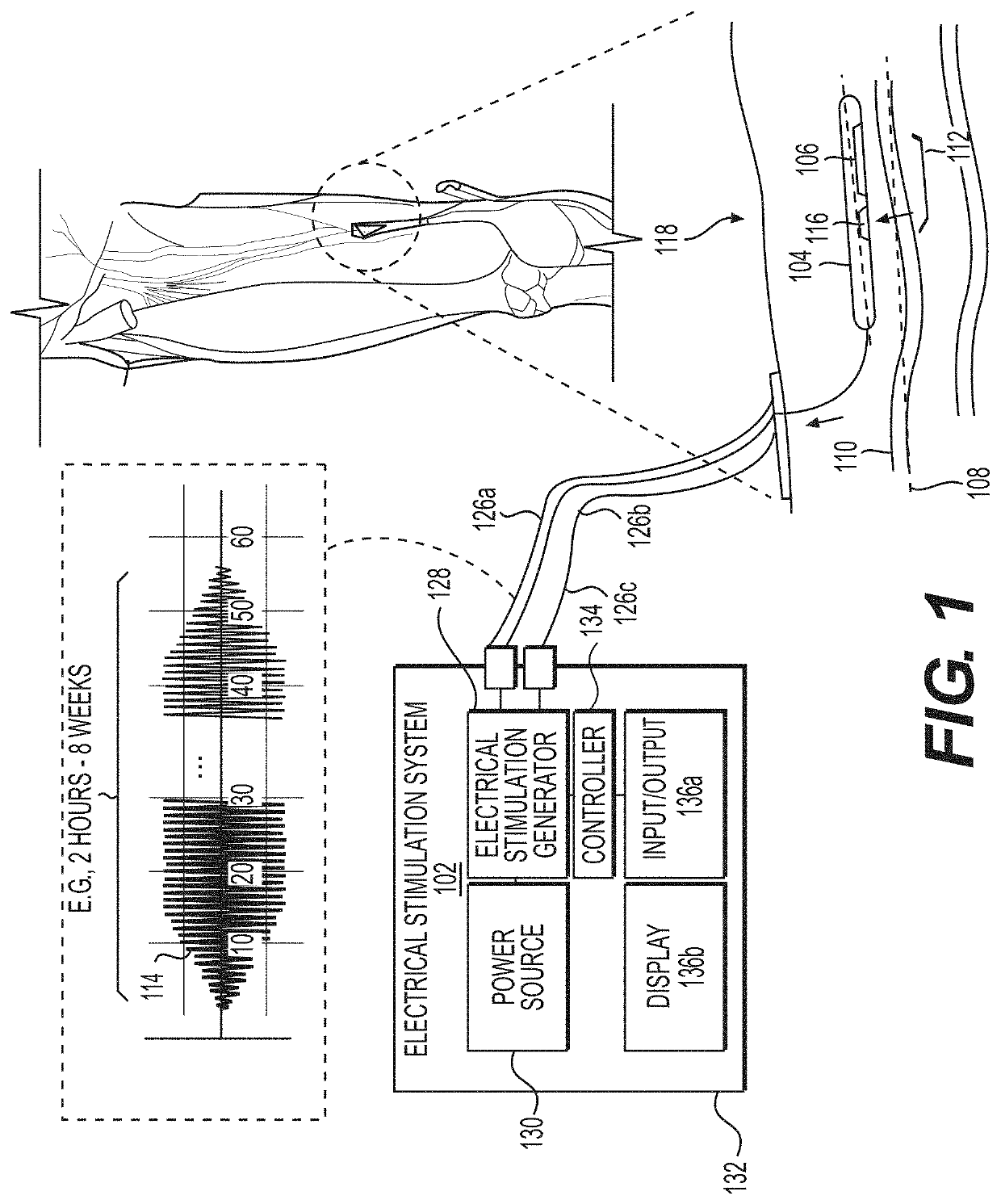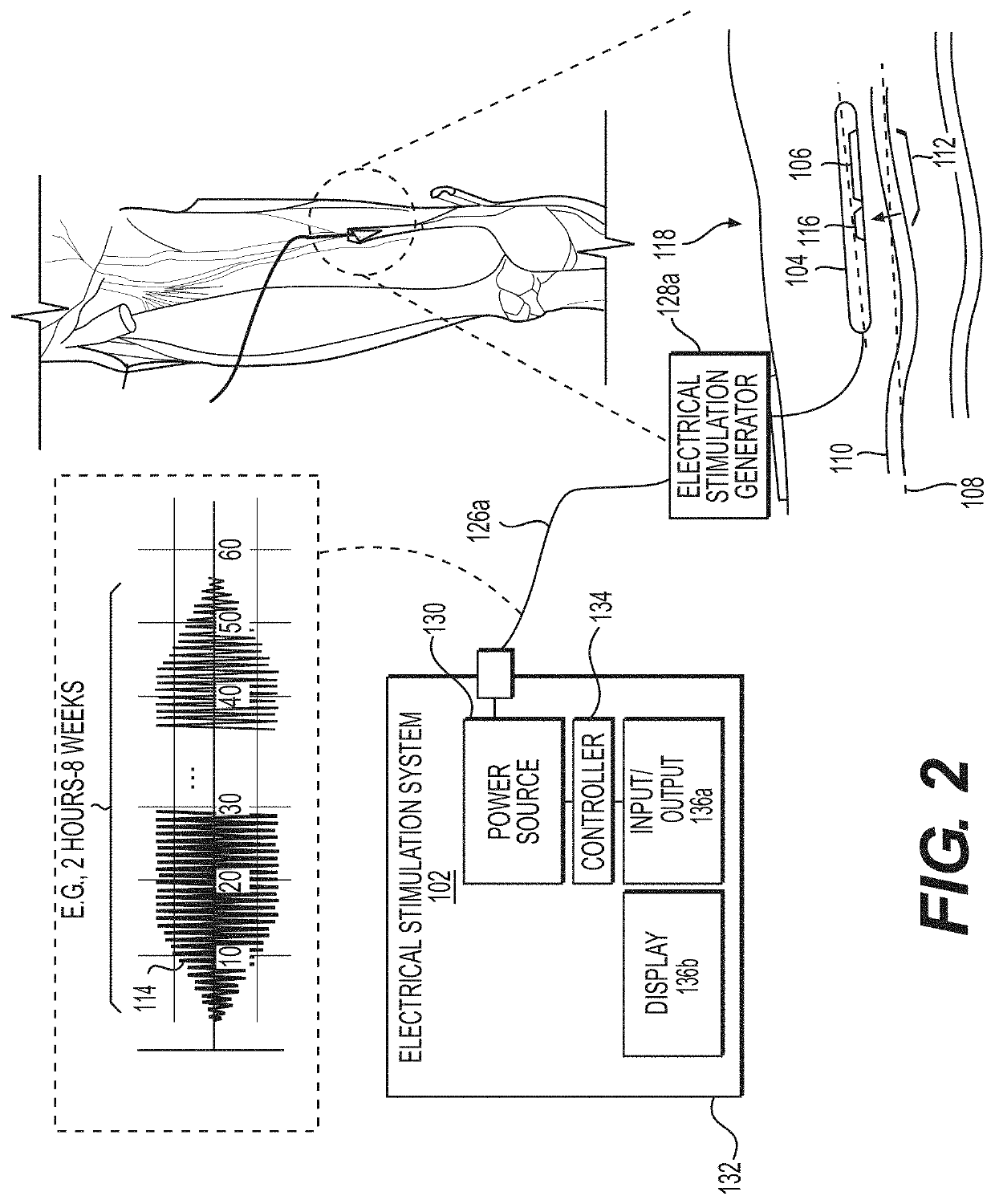System and method to percutaneously block painful sensations
a nerve fiber and percutaneous block technology, applied in the field of system and method to block nerve fiber activity, can solve the problems of uncomfortable sensations, uncomfortable motor contractions, and difficulty in the use of high-frequency electrical stimulation, and achieve the effect of facilitating complete, or near complete, blockage of nerve conduction
- Summary
- Abstract
- Description
- Claims
- Application Information
AI Technical Summary
Benefits of technology
Problems solved by technology
Method used
Image
Examples
example system # 1
Example System #1
[0212]FIG. 1 is a diagram of an exemplary electrical stimulation system 102 configured to deliver electrical stimulation 114 from a percutaneous lead 104 comprising one or more percutaneous electrode(s) 106 placed in parallel, or substantially in parallel, and without direct contact, to a long axis 108 of a target nerve 110 over an overlapping nerve region 112 of greater than about 3 millimeters, to block nerve conduction through the overlapping nerve region 112, in accordance with an illustrative embodiment. This overlapping nerve region 112 is also referred to herein as a point of nerve conduction block 112. A percutaneous electrode 106 does not have to directly contact the nerve trunk, e.g., the epineurium, though it can, and the electrode and its associated assembly can be offset from the nerve trunk by up to 15 millimeters. The intensity or power of the electrical stimulation may be adjusted to compensate for individual patient perception of pain as well as for...
example # 1
Example #1
[0387]FIG. 27 demonstrates the sensory response in an able-bodied subject to a percutaneously delivered high-frequency electrical stimulation. The sensations are consistent with the onset response elicited by high-frequency stimulation of a sensory nerve. An S8 (Abbott) electrode was used to stimulate the saphenous nerve at a site 5-to-10 cm proximal to the ankle. The stimulation consisted of a constant-current, 10 kHz sinusoidal waveform, and it was delivered for a period of 20 seconds at various amplitudes, including 4 mA (A—see reference number 2704), 6 mA (B—see reference number 2706), 10 mA (C—see reference number 2708), and 15 mA (D—see reference number 2710). The subject verbally described the quality of the evoked sensations (e.g. light-touch or pain) and indicated the intensity of the sensation on an 11-point scale: levels 1 and 2 defined tactile sensation, level 3 defined the pain threshold, and levels 4-10 indicated a mild-to-severe painful sensation.
[0388]FIG. ...
example # 2
Example #2
[0398]To determine if the onset response experienced when a 15-mA stimulation was delivered to the saphenous nerve could be minimized or eliminated, various ramping conditions were tested where the amplitude was allowed to gradually increase to the 15-mA level rather than being immediately set to 15-mA, after which time the 15-mA stimulation was delivered for a time period of 20 seconds. Specifically, the data from the 15-mA stimulation from Example #1 where no ramping was utilized was compared to two different ramping rates—(1) 1 milliamp / second and (2) 0.5 milliamps / second.
[0399]The results are shown in FIGS. 28A-28C and Table 2 below.
[0400]
TABLE 2AmplitudePeak SensationResponse AreaOnsetPeak LatencyOffsetOnset-Amp(mA)(0 to 8 Scale)(mA*s)(seconds)(seconds)(seconds)(mA)15(no ramp)7.54 (±0.27)58.74 (±4.82)0.39 (±0.03) 2.52 (±0.67)10.87 (±0.36)NA15(1 mA / s ramp)0.81 (±0.02) 7.08 (±0.94)5.89 (±0.38)16.56 (±2.35)20.67 (±1.78)5.3 (±0.26)15(0.5 mA / s ramp)N / AN / AN / AN / AN / AN / A
[0401]...
PUM
 Login to View More
Login to View More Abstract
Description
Claims
Application Information
 Login to View More
Login to View More - R&D
- Intellectual Property
- Life Sciences
- Materials
- Tech Scout
- Unparalleled Data Quality
- Higher Quality Content
- 60% Fewer Hallucinations
Browse by: Latest US Patents, China's latest patents, Technical Efficacy Thesaurus, Application Domain, Technology Topic, Popular Technical Reports.
© 2025 PatSnap. All rights reserved.Legal|Privacy policy|Modern Slavery Act Transparency Statement|Sitemap|About US| Contact US: help@patsnap.com



